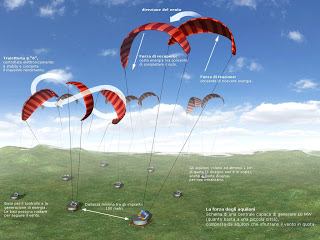

| Visitors Now: | |
| Total Visits: | |
| Total Stories: |

| Story Views | |
| Now: | |
| Last Hour: | |
| Last 24 Hours: | |
| Total: | |
Germans follow Italians, Americans and Canadian and others to Pursue Kite Generated Wind Power
From
Compared to conventional wind farm technology that relies on rotors, this technology offers a wide range of advantages. Wind speeds at ground level tend to zero, but they increase dramatically the higher you go. At a height of 100 meters wind speeds are around 15 meters a second; at 500 meters they exceed 20 meters a second. “The energy yield of a kite far exceeds that of a wind turbine, whose rotor tips turn at a maximum height of 200 meters. Doubling the wind speed results in eight times the energy,” says Montnacher. “Depending on wind conditions, eight kites with a combined surface area of up to 300 square meters can equate to 20 conventional 1-megawatt wind turbines.”
Kites do not have to struggle with the constancy of the wind the way turbines do, because the higher you go, the windier things get. Figures for the past year show that at a height of 10 meters, there is only about a 35 percent chance of wind speeds reaching 5 meters a second, but at 500 meters that likelihood goes up to 70 percent. This makes any number of new lowland sites viable for the production of wind energy. Another advantage is that it costs considerably less to build a system that, among other things, does not require towers each weighing hundreds of tons.
Many others are pursuing kite generated wind power.
The Italian Kitegen company has been a leader in developing kite generated wind power.
See more and subscribe to NextBigFuture at 2012-11-04 18:03:34 Source: http://nextbigfuture.com/2012/11/germans-follow-italians-americans-and.html
Source:



